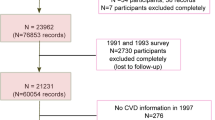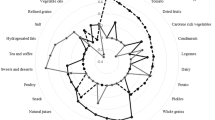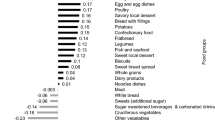Abstract
Background/Objectives:
The nutrient-rich food (NRF) index assesses nutrient quality of individual food items by ranking them according to their nutrient composition. The index reflects the nutrient density of the overall diet. We examined the associations between the NRF9.3 index—a score on the basis of nine beneficial nutrients (protein, fiber, vitamins and minerals) and three nutrients to limit (saturated fat, sugar and sodium)—incidence of cardiovascular disease (CVD) events and all-cause mortality.
Subjects/Methods:
A total of 4969 persons aged 55 and older from the Rotterdam Study, a prospective cohort study in the Netherlands, were studied. First, all foods were scored on the basis of their nutrient composition, resulting in an NRF9.3 score on food item level. Subsequently, they were converted into individual weighted scores on the basis of the amount of calories of each food item consumed by the subjects and the total energy intake. The hazard ratios (HRs) of the NRF9.3 index score were adjusted for age, gender, body mass index, smoking history, doctor-prescribed diet, alcohol consumption and education.
Results:
Food groups that contributed most to the NRF9.3 index score were vegetables, milk and milk products, fruit, bread and potatoes. A high NRF9.3 index score was inversely associated with all-cause mortality (HR Q4 versus Q1: 0.84 (95% confidence interval: 0.74, 0.96)). Associations were stronger in women than in men. The NRF9.3 index score was not associated with incidence of CVD.
Conclusion:
Elderly with a higher NRF9.3 index score, indicating more beneficial components and/or less limiting components, had a lower risk of all-cause mortality. Consuming a nutrient-dense diet may improve survival.
This is a preview of subscription content, access via your institution
Access options
Subscribe to this journal
Receive 12 print issues and online access
$259.00 per year
only $21.58 per issue
Buy this article
- Purchase on Springer Link
- Instant access to full article PDF
Prices may be subject to local taxes which are calculated during checkout
Similar content being viewed by others
References
U.S. Department of Agriculture and U.S. Department of Health and Human Services Dietary Guidelines for Americans, 2010. 2010, U.S. Government Printing Ofice: Washington, DC, USA.
Guenther PM, Reedy J, Krebs-Smith SM . Development of the Healthy Eating Index-2005. J Am Diet Assoc 2008; 108: 1896–1901.
Kennedy ET, Ohls J, Carlson S, Fleming K . The Healthy Eating Index: design and applications. J Am Diet Assoc 1995; 95: 1103–1108.
Huijbregts P, Feskens E, Rasanen L, Fidanza F, Nissinen A, Menotti A et al. Dietary pattern and 20 year mortality in elderly men in Finland, Italy, and The Netherlands: longitudinal cohort study. BMJ 1997; 315: 13–17.
Kant AK, Schatzkin A, Graubard BI, Schairer C . A prospective study of diet quality and mortality in women. JAMA 2000; 283: 2109–2115.
Osler M, Heitmann BL, Gerdes LU, Jorgensen LM, Schroll M . Dietary patterns and mortality in Danish men and women: a prospective observational study. Br J Nutr 2001; 85: 219–225.
Michels KB, Wolk A . A prospective study of variety of healthy foods and mortality in women. Int J Epidemiol 2002; 31: 847–854.
Knoops KT, Groot de LC, Fidanza F, Alberti-Fidanza A, Kromhout D, van Staveren WA . Comparison of three different dietary scores in relation to 10-year mortality in elderly European subjects: the HALE project. Eur J Clin Nutr 2006; 60: 746–755.
Lagiou P, Trichopoulos D, Sandin S, Lagiou A, Mucci L, Wolk A et al. Mediterranean dietary pattern and mortality among young women: a cohort study in Sweden. Br J Nutr 2006; 96: 384–392.
Trichopoulou A, Kouris-Blazos A, Wahlqvist ML, Gnardellis C, Lagiou P, Polychronopoulos E et al. Diet and overall survival in elderly people. BMJ 1995; 311: 1457–1460.
Drewnowski A . Defining nutrient density: development and validation of the nutrient rich foods index. J Am Coll Nutr 2009; 28: 421S–426S.
Miller GD, Drewnowski A, Fulgoni V, Heaney RP, King J, Kennedy E . It is time for a positive approach to dietary guidance using nutrient density as a basic principle. J Nutr 2009; 139: 1198–1202.
Fulgoni VL 3rd, Keast DR, Drewnowski A . Development and validation of the nutrient-rich foods index: a tool to measure nutritional quality of foods. J Nutr 2009; 139: 1549–1554.
Hofman A, Grobbee DE, de Jong PT, van den Ouweland FA . Determinants of disease and disability in the elderly: the Rotterdam Elderly Study. Eur J Epidemiol 1991; 7: 403–422.
van Rossum CT, van de Mheen H, Witteman JC, Grobbee E, Mackenbach JP . Education and nutrient intake in Dutch elderly people. The Rotterdam Study. Eur J Clin Nutr 2000; 54: 159–165.
Geleijnse JM, Vermeer C, Grobbee DE, Schurgers LJ, Knapen MH, van der Meer IM et al. Dietary intake of menaquinone is associated with a reduced risk of coronary heart disease: the Rotterdam Study. J Nutr 2004; 134: 3100–3105.
Leening MJ, Kavousi M, Heeringa J, van Rooij FJ, Verkroost-van Heemst J, Deckers JW et al. Methods of data collection and definitions of cardiac outcomes in the Rotterdam Study. Eur J Epidemiol 2012; 27: 173–185.
Klipstein-Grobusch K, den Breeijen JH, Goldbohm RA, Geleijnse JM, Hofman A, Grobbee DE et al. Dietary assessment in the elderly: validation of a semiquantitative food frequency questionnaire. Eur J Clin Nutr 1998; 52: 588–596.
Nederlands voedingsstoffenbestand. 1993, Voorlichtingsbureau voor de Voeding: Den Haag.
Nederlands voedingsstoffenbestand. 1996, Voorlichtingsbureau voor de Voeding: Den Haag.
Commission Directive 2008/100/EC of 28 October 2008 amending Council Directive 90/496/EEC on nutrition labelling for foodstuffs as regards recommended daily allowances, energy conversion factors and definitions. Official J Eur Union 2008; 285: 9–12.
EFSA Panel on Dietetic Products Nutrition and Allergies. Scientific Opinion on Dietary Reference Values for protein. EFSA J 2012; 10: 2557.
EFSA Panel on Dietetic Products Nutrition and Allergies. Review of labelling reference intake values: Scientific Opinion of the Panel on Dietetic products, Nutrition and Allergies on a request from the European Commission on the review of labelling reference intake values for selected nutritional elements. EFSA J 2009; 1008: 1–14.
EFSA Panel on Dietetic Products N, and Allergies. Scientific Opinion on Dietary Reference Values for carbohydrates and dietary fibre. EFSA J 2010; 8: 1462.
EFSA Panel on Dietetic Products N, and Allergies. Scientific Opinion on Dietary Reference Values for fats, including saturated fatty acids, polyunsaturated fatty acids, trans fatty acids, and cholesterol. EFSA J 2010; 8: 1461.
1999 World Health Organization-International Society of Hypertension Guidelines for the Management of Hypertension. Guidelines Subcommittee. J Hypertens 1999; 17: 151–183.
Stel VS, Smit JH, Pluijm SM, Visser M, Deeg DJ, Lips P . Comparison of the LASA Physical Activity Questionnaire with a 7-day diary and pedometer. J Clin Epidemiol 2004; 57: 252–258.
Hofman A, van Duijn CM, Franco OH, Ikram MA, Janssen HL, Klaver CC et al. The Rotterdam Study: 2012 objectives and design update. Eur J Epidemiol 2011; 26: 657–686.
Gil A, Ortega RM, Maldonado J . Wholegrain cereals and bread: a duet of the Mediterranean diet for the prevention of chronic diseases. Public Health Nutr 2011; 14: 2316–2322.
Hartley L, Igbinedion E, Holmes J, Flowers N, Thorogood M, Clarke A et al. Increased consumption of fruit and vegetables for the primary prevention of cardiovascular diseases. Cochrane Database Syst Rev 2013; 6: CD009874.
Ignarro LJ, Balestrieri ML, Napoli C . Nutrition, physical activity, and cardiovascular disease: an update. Cardiovasc Res 2007; 73: 326–340.
Soedamah-Muthu SS, Ding EL, Al-Delaimy WK, Hu FB, Engberink MF, Willett WC et al. Milk and dairy consumption and incidence of cardiovascular diseases and all-cause mortality: dose-response meta-analysis of prospective cohort studies. Am J Clin Nutr 2011; 93: 158–171.
Larsson SC, Orsini N . Red meat and processed meat consumption and all-cause mortality: a meta-analysis. Am J Epidemiol 2013; 179: 282–289.
Rohrmann S, Overvad K, Bueno-de-Mesquita HB, Jakobsen MU, Egeberg R, Tjonneland A et al. Meat consumption and mortality—results from the European Prospective Investigation into Cancer and Nutrition. BMC Med 2013; 11: 63.
Salter AM . Dietary fatty acids and cardiovascular disease. Animal 2013; 7: 163–171.
Mozaffarian D, Kumanyika SK, Lemaitre RN, Olson JL, Burke GL, Siscovick DS . Cereal, fruit, and vegetable fiber intake and the risk of cardiovascular disease in elderly individuals. JAMA 2003; 289: 1659–1666.
Garsetti M, de Vries J, Smith M, Amosse A, Rolf-Pedersen N . Nutrient profiling schemes: overview and comparative analysis. Eur J Nutr 2007; 46: 15–28.
Azais-Braesco V, Goffi C, Labouze E . Nutrient profiling: comparison and critical analysis of existing systems. Public Health Nutr 2006; 9: 613–622.
Katz DL, Njike VY, Faridi Z, Rhee LQ, Reeves RS, Jenkins DJ et al. The stratification of foods on the basis of overall nutritional quality: the overall nutritional quality index. Am J Health Promot 2009; 24: 133–143.
Katz DL, Njike VY, Rhee LQ, Reingold A, Ayoob KT . Performance characteristics of NuVal and the Overall Nutritional Quality Index (ONQI). Am J Clin Nutr 2010; 91: 1102S–1108S.
Chiuve SE, Sampson L, Willett WC . The association between a nutritional quality index and risk of chronic disease. Am J Prev Med 2011; 40: 505–513.
Drewnowski A . The Nutrient Rich Foods Index helps to identify healthy, affordable foods. Am J Clin Nutr 2010; 91: 1095S–1101S.
Mobley AR, Kraemer D, Nicholls J . Putting the nutrient-rich foods index into practice. J Am Coll Nutr 2009; 28: 427S–435S.
Drewnowski A, Maillot M, Darmon N . Should nutrient profiles be based on 100 g, 100 kcal or serving size? Eur J Clin Nutr 2009; 63: 898–904.
Bentley B . A review of methods to measure dietary sodium intake. J Cardiovasc Nurs 2006; 21: 63–67.
Acknowledgements
We thank Anouk Engelen, MSc from Wageningen University for providing us with data on added sugars. The present study was partially supported by an unrestricted grant from the Dutch Dairy Foundation and by a grant from the Cooperative Research Program for Agriculture Science & Technology Development (no. PJ007208), Rural Development Administration, Republic of Korea. The Rotterdam Study is supported by the Erasmus Medical Center and Erasmus University Rotterdam, the Netherlands Organization of Scientific Research (NWO), the Netherlands Organization for Health Research and Development (ZonMw), the Research Institute for Diseases in the Elderly (RIDE), the Ministry of Education, Culture and Science, the Ministry of Health, Welfare and Sports and the European Commission (DG XII).
Disclaimer
The sponsors had no input in the design, the conduct, the analysis or the interpretation of the study, and did not influence the manuscript preparation.
Author contributions
All authors had full access to all of the data (including statistical reports and tables) and take responsibility for the integrity of the data and the accuracy of the data analysis. AH and JW were responsible for study concept and design. OHF, AH and JCMW acquired the data. MTS, DS, JFvY, AG and EJMF analyzed and interpreted the data. MTS, DS and JFvY drafted the manuscript, which was critically revised for important intellectual content by all authors. MTS, DS and EJMF were responsible for the statistical analysis. EJMF supervised the study and is guarantor.
Author information
Authors and Affiliations
Corresponding author
Ethics declarations
Competing interests
The authors declare no conflict of interest.
Rights and permissions
About this article
Cite this article
Streppel, M., Sluik, D., van Yperen, J. et al. Nutrient-rich foods, cardiovascular diseases and all-cause mortality: the Rotterdam study. Eur J Clin Nutr 68, 741–747 (2014). https://doi.org/10.1038/ejcn.2014.35
Received:
Revised:
Accepted:
Published:
Issue Date:
DOI: https://doi.org/10.1038/ejcn.2014.35
This article is cited by
-
Validation of Food Compass with a healthy diet, cardiometabolic health, and mortality among U.S. adults, 1999–2018
Nature Communications (2022)
-
Association of energy adjusts nutrient-rich foods on mental health among obese and overweight women: a cross-sectional study
Eating and Weight Disorders - Studies on Anorexia, Bulimia and Obesity (2022)
-
Food loss and waste metrics: a proposed nutritional cost footprint linking linear programming and life cycle assessment
The International Journal of Life Cycle Assessment (2020)
-
Fruit and vegetable intake and mortality from cardiovascular disease in Japan: a 24-year follow-up of the NIPPON DATA80 Study
European Journal of Clinical Nutrition (2015)



